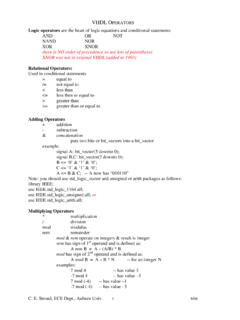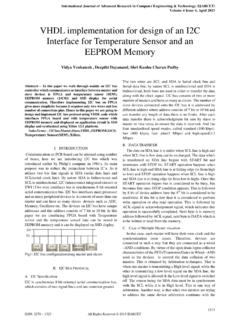Transcription of Circuit Design with VHDL
1 Circuit Design with vhdl 1st Edition Volnei A. Pedroni, MIT Press, 2004 Selected Exercise Solutions Problem : Multiplexer ---------------------------------------- ---------- LIBRARY ieee; USE ; ---------------------------------------- ---------- ENTITY mux IS PORT ( a, b: IN STD_LOGIC_VECTOR(7 DOWNTO 0); sel: IN STD_LOGIC_VECTOR(1 DOWNTO 0); c: OUT STD_LOGIC_VECTOR(7 DOWNTO 0)); END mux; ---------------------------------------- ---------- ARCHITECTURE example OF mux IS BEGIN PROCESS (a, b, sel) BEGIN IF (sel="00") THEN c <= "00000000"; ELSIF (sel="01") THEN c <= a; ELSIF (sel="10") THEN c <= b; ELSE c <= (OTHERS => 'Z'); --or c<="ZZZZZZZZ"; END IF; END PROCESS; END example; ---------------------------------------- ---------- Problem : Dealing with data types First, recall figure , which shows four types of data structures.
2 From it, we conclude the following: a: a scalar of type BIT b: a scalar of type STD_LOGIC x: a 1D array (a vector) of type ARRAY1, whose 8 individual elements are of type STD_LOGIC y: a 2D array (a matrix) of type ARRAY2, whose 4x8=32 individual elements are of type STD_LOGIC w: a 1Dx1D array (another matrix) of type ARRAY3, whose 4 individual 8 element vectors are of type ARRAY1 z: another 1D array (another vector) whose 8 individual elements are again of type STD_LOGIC Therefore: Circuit Design with vhdl , 1st edition, Volnei A. Pedroni, MIT Press, 2004 Selected Exercise Solutions 2 a <= x(2); a: scalar, type BIT x(2): scalar, type STD_LOGIC Assignment is illegal (type mismatch) b <= x(2); b: scalar, type STD_LOGIC x(2): scalar, type STD_LOGIC Assignment is legal b <= y(3,5); b: scalar, type STD_LOGIC y(3,5): scalar, type STD_LOGIC, with valid indexing Assignment is legal b <= w(5)(3); b: scalar, type STD_LOGIC w(5)(3): scalar, type STD_LOGIC, but 5 is out of bounds Assignment is illegal y(1)(0) <= z(7); y(1)(0): scalar, type STD_LOGIC, but indexing is incorrect because y is 2D (it should be y(1,0)) z(7): scalar, type STD_LOGIC Assignment is illegal x(0) <= y(0,0); x(0): scalar, type STD_LOGIC y(0,0): scalar, type STD_LOGIC, valid indexing Assignment is legal x <= 1110000 ; x: 8 bit vector (1D) Assignment would be legal if it contained 8 values instead of 7 a <= 0000000.
3 A: scalar, so can only have one bit Assignment is illegal y(1) <= x; y(1): in principle, an 8 element vector, extracted from a 2D matrix, whose individual elements are of type STD_LOGIC; however, the indexing (slicing) of y is not valid, because the matrix is 2D, not 1Dx1D x: an 8 element vector of type ARRAY1 Assignment is illegal (invalid slicing + type mismatch) w(0) <= y; w(0): row 0 of a 1Dx1D matrix, which is an 8 element vector of type ARRAY1 y: a 4x8 (2D) matrix Assignment is illegal (size + type mismatches) w(1) <= (7=>'1', OTHERS=>'0'); w(1): row 1 of a 1Dx1D matrix Assignment is legal (w(1)<= 10000000 ) y(1) <= (0=>'0', OTHERS=>'1'); y(1): in principle, row 1 of a matrix, but the indexing is invalid, because the matrix is 2D, not 1Dx1D Assignment y(1)<= 11111110 is illegal Circuit Design with vhdl , 1st edition, Volnei A. Pedroni, MIT Press, 2004 Selected Exercise Solutions 3 w(2)(7 DOWNTO 0) <= x; w(2)(7 DOWNTO 0): row 2 of a 1Dx1D matrix, which is an 8 element vector of type ARRAY1 x: an 8 element vector of type ARRAY1 Assignment is legal Note: w(2) <= x would be fine too w(0)(7 DOWNTO 6) <= z(5 DOWNTO 4); w(0)(7 DOWNTO 6): the leftmost 2 elements of row 0 of a 1Dx1D matrix, being each row an 8 element vector of type ARRAY1 z(5 DOWNTO 4): 2 elements of an 8 element STD_LOGIC_VECTOR Assignment is illegal (type mismatch) x(3) <= x(5 DOWNTO 5); x(3): a scalar of type STD_LOGIC x(5 DOWNTO 5): also a scalar of type STD_LOGIC Assignment is legal b <= x(5 DOWNTO 5) b: a scalar of type STD_LOGIC x(5 DOWNTO 5): also a scalar of type STD_LOGIC Assignment is legal y <= ((OTHERS=>'0'), (OTHERS=>'0'), (OTHERS=>'0'), 10000001 ); y is a 2D matrix Assignment is legal.
4 Note: Since y is 2D, some older compilers might not accept the vector like assignments above, thus requiring the assignment to be made element by element ( with GENERATE, for example). Note: The assignment below is also legal. y <= (('0','0','0','0','0','0','0','0'), ('0','0','0','0','0','0','0','0'), ('0','0','0','0','0','0','0','0'), ('1','0','0','0','0','0','0','1')); z(6) <= x(5); z(6): scalar of type STD_LOGIC x(5): also a scalar of type STD_LOGIC (though as a vector x is of type ARRAY1, as a scalar ( base type) it is STD_LOGIC) z(6 DOWNTO 4) <= x(5 DOWNTO 3); z(6 DOWNTO 4): 3 element vector of type STD_LOGIC_VECTOR x(5 DOWNTO 3): 3 element vector of type ARRAY1 Assignment is illegal (type mismatch) z(6 DOWNTO 4) <= y(5 DOWNTO 3); The indexing of y is invalid (slicing 2D array is generally not allowed) Assignment is illegal y(6 DOWNTO 4) <= x(3 TO 5); The indexing of y is invalid (slicing 2D array is generally not allowed) Indexing of x is in the wrong direction Assignment is illegal y(0, 7 DOWNTO 0) <= z.
5 Y(0, 7 DOWNTO 0): in principle, row 0 of a matrix, but slicing 2D arrays is generally not supported Assignment is illegal w(2,2) <= '1'; w is 1Dx1D, so indexing should be w(2)(2) Assignment is illegal Circuit Design with vhdl , 1st edition, Volnei A. Pedroni, MIT Press, 2004 Selected Exercise Solutions 4 Problem : Operators x1 <= a --x1 = 10010 x2 <= c --x2 = 00101100 x3 <= b XOR c; --x3 = 1110 x4 <= a NOR b(3); --x4 = '0' x5 <= b sll 2; --x5 = 0000 x6 <= b sla 2; --x6 = 0000 x7 <= b rol 2; --x7 = 0011 ; x8 <= a AND NOT b(0) AND NOT c(1); --x8 = '0' d <= (5=>'0', OTHERS=>'1'); --d = 11011111 Problem : Generic Multiplexer Solution 1: In this solution, no package is employed.
6 Notice however that x was not defined as a 1Dx1D or 2D structure (chapter 3); instead, it was specified as simply a long vector of length m(2n). Though this will not affect the result, such a linearization might be confusing sometimes, so is not recommended in general. ---------------------------------------- ------ ENTITY generic_mux IS GENERIC ( n: INTEGER := 4; --number of selection bits m: INTEGER := 8); --number of bits per input PORT ( x: IN BIT_VECTOR (m*2**n-1 DOWNTO 0); sel: IN INTEGER RANGE 0 TO 2**n-1; y: OUT BIT_VECTOR (m-1 DOWNTO 0)); END generic_mux; ---------------------------------------- ------ ARCHITECTURE generic_mux OF generic_mux IS BEGIN gen: FOR i IN m-1 DOWNTO 0 GENERATE y(i) <= x(m*sel+i); END GENERATE gen; END generic_mux; ---------------------------------------------- Solution 2: Here, a user defined (in a package) type is employed --- Package: ------------------------------------------------- PACKAGE my_data_types IS TYPE matrix IS ARRAY (NATURAL RANGE <>, NATURAL RANGE <>) OF BIT; END PACKAGE my_data_types.
7 ---------------------------------------- ----------------------- --- Main code: ---------------------------------------- -------- USE ; ---------------------------------------- ----------------------- ENTITY generic_mux IS GENERIC ( inputs: INTEGER := 16; --number of inputs size: INTEGER := 8); --size of each input PORT ( x: IN MATRIX (0 TO inputs-1, size-1 DOWNTO 0); sel: IN INTEGER RANGE 0 TO inputs-1; y: OUT BIT_VECTOR (size-1 DOWNTO 0)); END generic_mux; ---------------------------------------- ----------------------- ARCHITECTURE arch OF generic_mux IS BEGIN gen: FOR i IN size-1 DOWNTO 0 GENERATE y(i) <= x(sel, i); END GENERATE gen; END arch; ---------------------------------------- ----------------------- Circuit Design with vhdl , 1st edition, Volnei A. Pedroni, MIT Press, 2004 Selected Exercise Solutions 5 Problem : Unsigned adder A possible solution is shown below (but see the NOTE that follows).
8 The ports were considered to be of type STD_LOGIC (industry standard). Simulation results are included after the code. ---------------------------------------- -------------------------------- LIBRARY ieee; USE ; USE ; --allows arith. operations w/ STD_LOGIC ---------------------------------------- -------------------------------- ENTITY adder IS PORT ( a, b: IN STD_LOGIC_VECTOR(7 DOWNTO 0); sum: OUT STD_LOGIC_VECTOR(7 DOWNTO 0); cout: OUT STD_LOGIC); END adder; ---------------------------------------- -------------------------------- ARCHITECTURE adder OF adder IS SIGNAL long_a, long_b, long_sum: STD_LOGIC_VECTOR(8 DOWNTO 0); BEGIN long_a <= '0' long_b <= '0' long_sum <= long_a + long_b; sum <= long_sum(7 DOWNTO 0); cout <= long_sum(8); END adder; ---------------------------------------- -------------------------------- NOTE: Even though the solution above is fine in principle, the recommended approach for arithmetic circuits is to explicitly convert the inputs to UNSIGNED or SIGNED (so it will be clear that the unsigned/signed issue was considered), do the computations, then return the result to STD_LOGIC_VECTOR (to be sent out).
9 The reader is invited to redo this problem taking into account the recommendation above. Simulation results for Problem Problem : Binary to Gray code converter The gray codeword g(N 1:0) corresponding to a regular binary codeword b(N 1:0) can be obtained as follows: For i = N 1: g(i) = b(i) For i = N 2 .. 0: g(i) = b(i) b(i+1) A corresponding generic vhdl code is presented below, followed by simulation results for N=4. ---------------------------------------- ----------------- LIBRARY ieee; USE ; ---------------------------------------- ----------------- ENTITY gray_encoder IS GENERIC (N: INTEGER := 4); PORT (b: IN STD_LOGIC_VECTOR(N-1 DOWNTO 0); g: OUT STD_LOGIC_VECTOR(N-1 DOWNTO 0)); END gray_encoder; ---------------------------------------- ----------------- ARCHITECTURE gray_encoder OF gray_encoder IS BEGIN g(N-1) <= b(N-1); g(N-2 DOWNTO 0) <= b(N-2 DOWNTO 0) XOR b(N-1 DOWNTO 1); END gray_encoder; Circuit Design with vhdl , 1st edition, Volnei A.
10 Pedroni, MIT Press, 2004 Selected Exercise Solutions 6 ---------------------------------------- ----------------- Simulation results for Problem Problem : Four stage shift register -------------------------------- LIBRARY ieee; USE ; -------------------------------- ENTITY shift_reg IS PORT ( clk, din: IN STD_LOGIC; dout: OUT STD_LOGIC); END shift_reg; -------------------------------- ARCHITECTURE shift_reg OF shift_reg IS SIGNAL d: STD_LOGIC_VECTOR(3 DOWNTO 0); BEGIN PROCESS(clk) BEGIN IF (clk'EVENT AND clk='1') THEN d <= din & d(3 DOWNTO 1); END IF; END PROCESS; dout <= d(0); END shift_reg; -------------------------------- Problem : Generic frequency divider ----Clock frequency is divided by N----------- LIBRARY ieee; USE ; ---------------------------------------- ------ ENTITY clock_divider IS GENERIC (N: POSITIVE := 7); PORT (clkin: IN STD_LOGIC; clkout: OUT STD_LOGIC); END ENTITY; ---------------------------------------- ------ ARCHITECTURE clock_divider OF clock_divider IS BEGIN PROCESS (clkin) VARIABLE count: INTEGER RANGE 0 TO N; BEGIN IF (clkin'EVENT AND clkin='1') THEN count := count + 1; IF (count=N/2) THEN clkout <= '1'; ELSIF (count=N) THEN clkout <= '0'; count := 0; END IF; END IF; END PROCESS; END ARCHITECTURE; ---------------------------------------- ----- NOTE: In the solution above the duty cycle is not symmetric when N is odd (see simulation results below).








